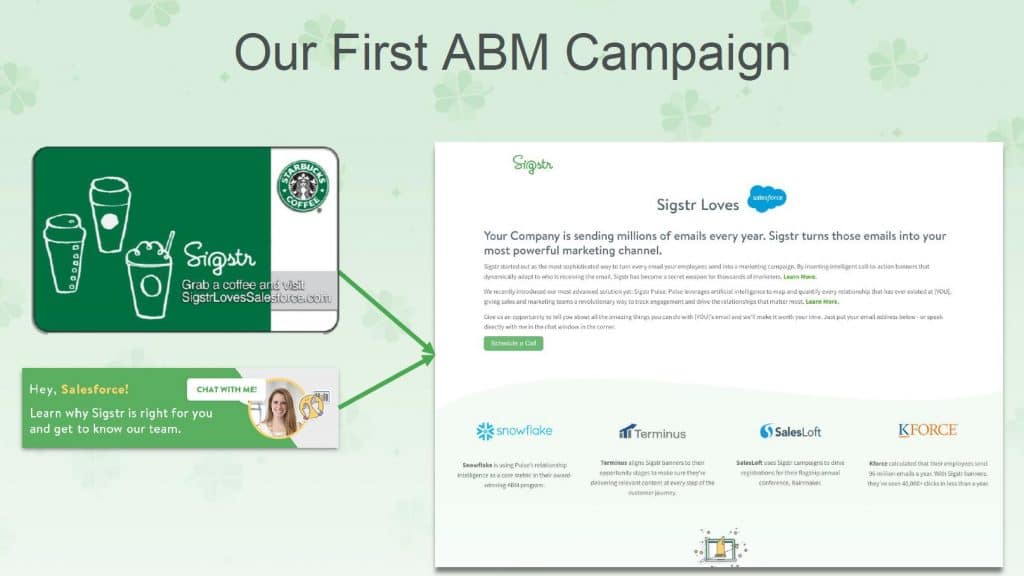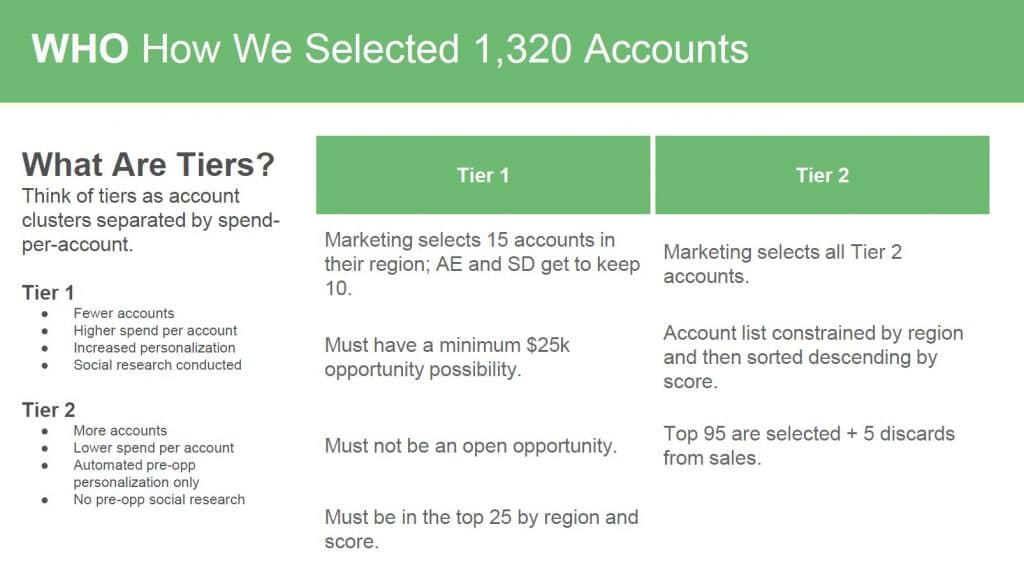At Inbound I attended a session presented by Sigstr, a company that delivers email marketing by appending different footers to emails. We use one of their competitors to do exactly the same thing: please do ask if you want more information.
During the presentation, the speaker, Justin produced one of the wisest comments I’ve heard about ABM: “ABM is just good strategic marketing with personalisation”.
The presentation started off with some general “why you should do ABM” statistics. Although I think almost everyone has seen these stats, they are worth repeating because although we all know the benefits of ABM, not everyone is taking advantage.
- ABM outperforms all other marketing channels by 91%. Typically, 2% of leads convert.
- ABM increases win rate by 38%
- ABM delivers a 200% increase in revenue compared with other channels.
First Steps in ABM: One Target Account
Sigstr started by targeting a client they had previously lost, Salesforce. Their campaign was creative – they bought the URL sigstrlovessalesforce.com, built a simple one-page website and had Starbucks cards made with the URL on them. They sent the cards to 10 people they were targeting in Salesforce and also started putting footers on emails that went to Salesforce contacts. As the website was blocked from being indexed, they knew as soon as they saw traffic it must be a result of the campaign.
This experimental campaign taught them a lot, but sadly – despite the clever idea of creating a website specifically for this ABM campaign – they didn’t manage to win Salesforce back as a customer. Despite this they decided to expand the campaign to the next stage.
Growing ABM: 100 Target Accounts
The next step was to expand to 100 accounts, and this required the generation of a suitable target account list. This was perhaps the biggest problem, and required the following process:
- Create a clear ICP (ideal customer profile). Don’t build off previous customers only: look to the future too
- Choose accounts that have something in common – a common audience. It’s hard to build 100 different messages, but if audience is common then can use the same message.
- Sales and marketing finalise the selection
Rather than creating 100 websites, Sigstr built 100 landing pages on the standard template, having first built a spreadsheet to determine what goes where for each landing page to make the implementation as easy as possible. The most important thing for these pages was to make them feel highly personalised to each of the target companies.
Sigstr built a content matrix mapping the three personas and three industries targeted in the campaign to make it easier to determine what content was included on each page. Apparently, it was this content matrix that was one of the main factors in simplifying the development of so many different landing pages.
Sigstr’s team believed that there were only a few ways to reach accounts in an ABM campaign: targeted advertising, email, direct mail and phone/meeting. Although the Starbucks cards didn’t work in the first campaign, they chose direct mail and made boxes of “swag” to send to contacts in the target account. Initially they did this in house, but later on moved to a third-party provider, Sendoso.
The campaign did include advertising, email, phone calls and meetings. Interestingly, they highlighted phone as the least effective channel, mainly because of the difficulty in getting hold of people on the telephone. Meetings were the most effective as they had the highest value interaction.
SIgstr built a technology stack to deliver these campaigns, using the following vendors:
- Targeted advertising: Terminus, LinkedIn, DemandBase, Sense and RollWorks
- Emails: SalesLoft, Outreach and Sigstr (of course!)
- Direct Mail: Sendoso, PFL, Printfection and alyce
For this campaign they changed metrics that were monitored from cost per lead to cost per opportunity and cost per customer. Perhaps surprisingly one of the biggest problems with this was that it took longer than expected to secure the customer, even with the relatively short sales cycle of Sigstr. This meant that early on it was hard to see progress, and so the team actively sought out opportunities to celebrate success.
This campaign did result in opportunities in sales, and generated three key lessons that were used to inform the next campaign:
- Measure based on cost per opportunity or customer acquisition cost, rather than marketing metrics
- Get sales to care: if sales are not involved the campaign will not work
- Focusing on revenue as being the primary KPI
Expansion to 1000 ABM Accounts
The next stage in Sigstr’s ABM campaigns was to roll out to 1000 accounts. At this stage they needed to purchase a tool to create a scoring framework to select the accounts as discussions with sales would have taken too long for this many companies.
Accounts were also tiered, with more money being spent attracting tier 1 accounts than tier 2. If a second-tier account engaged with the campaign, however, then their priority was raised and so was the budget for that account. The picture below shows how they managed the criteria of their tiers:
Scaling up to a thousand accounts also made manual creation of customised landing pages impractical, so Sigstr deployed Drift to create the pages using a standard template. Interestingly, the campaign didn’t always root prospects to the Sigstr website. For SaaS services like Sigstr review sites are very important. So many people were directed to the Sigstr reviews on G2 Crowd.
Adverts were personalised with the target company’s name. The ABM campaign also ran during onboarding, with ads during the process and a request for review on G2 after the customer was up and running.
One of the most interesting insights about ABM was the difference Sigstr saw in the journeys different customers took. Although they tried to map out the ideal customer journey, real customers didn’t play ball and almost everybody took a slightly different journey. Flexibility is clearly an important element of any ABM campaign.
Although there were other problems, for example attribution became very difficult, the campaign was very successful and 65% of deals closed were from ABM campaign. ABM resulted in a 75% increase in ACV and saw a 5-day decrease in sales cycle. 30% of the tier 1 and 11% of the tier 2 target accounts became opportunities.
The Next Steps
Sigstr identified three changes that they are implementing to further improve their ABM campaigns:
- Reducing the number of targeted accounts – they are down to about 600 accounts, but also moving up market to target bigger companies. Of course, this introduces the challenge that the sales cycle is a bit longer with larger opportunities.
- Outbound has been moved from sales into marketing to make management of ABM easier
- Events are now a key part of the campaigns and they invite the key accounts to the event or side event that Sigstr is hosting to create more meetings
Three ABM Insights
My top three insights were:
- ABM really does work if you keep at it, although sales cycles for ABM are likely to be longer than for inbound enquiries
- “ABM is just good strategic marketing with personalisation” – don’t over-think it!
- Flexibility is important: no two accounts are going to follow exactly the same customer journey, no matter how much planning you put into your ideal journey
Source
These notes were taken when I attended From No ABM Program to Award-Winning ABM Program in Just One Year at Inbound 2019 presented by Justin Keller, VP Marketing at Sigstr.
Author
-
In 2001 Mike acquired Napier with Suzy Kenyon. Since that time he has directed major PR and marketing programmes for a wide range of technology clients. He is actively involved in developing the PR and marketing industries, and is Chair of the PRCA B2B Group, and lectures in PR at Southampton Solent University. Mike offers a unique blend of technical and marketing expertise, and was awarded a Masters Degree in Electronic and Electrical Engineering from the University of Surrey and an MBA from Kingston University.
View all posts




Hi,
Thanks a lot for so great content
We have used it for our article
https://datarob.com/ideal-customer-profile-b2b-full-guide-definition-templates-creation-segmentation/
BR
T